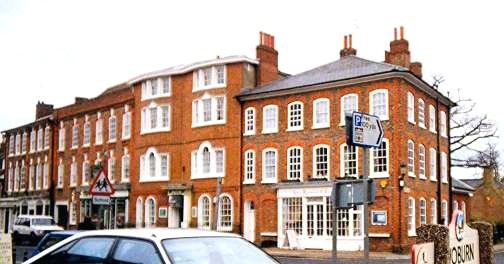Woburn
[From Samuel Lewis's Topographical Dictionary of England 1831.]
WOBURN, a market town and parish in the hundred of MANSHEAD, county of BEDFORD, 15 Miles (S.W. by S.) from Bedford, and 42 (N.W. by N.) from London, containing 1656 inhabitants. This town, which, having suffered from fire in 1505, and again in 1724, has been almost entirely rebuilt, occupies a gentle eminence on the main road from London to Leeds, and consists of several broad and handsome streets, which intersect each other at right angles, and are well paved with pebbles; the inhabitants are amply supplied with water from wells: the approaches to it, both from the north and the south, are kept in excellent repair. In the immediate vicinity is Woburn Abbey, with its noble and extensive park, the seat of His Grace the Duke of Bedford, which occupies the site of a Cistercian Abbey, founded, in 1145, by Hugh de Bolbeck, the revenue of which, at the dissolution, was valued at £430.13.11.: the site, with great part of the lands, was granted, in 1574, by Edward VI., to John, Lord Russell. In the middle of the last century the abbey was almost entirely rebuilt, by Flitcroft, since which time considerable enlargements have been made, under the superintendence of Mr. Holland, architect of Drury-lane theatre. This magnificent pile occupies the four sides of a quadrangle, and comprises various suites of apartments: the principal state-rooms are in the west front, which is of the Ionic order of architecture; and the gallery contains a highly valuable collection of portraits. The park is well stocked with deer, and abundantly supplied with game, and, being open to the inhabitants, affords many interesting walks. Queen Elizabeth made a journey to this place, in 1572 ; and when Charles I. visited Woburn, in 1645, notwithstanding that the Earl of Bedford was then in the service of the parliament, the monarch slept at the abbey. Assemblies, respectably attended, are occasionally held in the town during the winter months. The principal branches of manufacture are those of straw-plat and thread-lace, which are considerable. The market is on Friday; and fairs are held on January 1st, Match 23rd, July 13th, and October 6th : the spring fair is noted for an abundant supply of horses. The market-house, in the centre of the town, is a handsome square brick building, with a stuccoed front; it is three stories high, and is surmounted by a cupola and vane : the lower part is principally appropriated to the use of the butchers, and the upper end is for corn, butter, and cheese: this edifice was erected, after the great fire in 1724, at the expense of the Bedford family, and has been much improved by the present Duke. Manorial courts are held occasionally, at which constables are appointed. The county magistrates hold here a petty session for the hundred, on the first Friday in every month.
The living is a perpetual curacy, in the peculiar jurisdiction of the Incumbent, and in the patronage of the Duke of Bedford. The church, which is dedicated to St. Mary, was erected by Robert Hobbs, the last abbot of Woburn: it presents a singular appearance, being nearly covered with ivy. About six yards from the north aisle, and detached from the main building, is a Quadrangular embattled tower, scarcely fifty feet high, strengthened with buttresses at the angles, terminating in pinnacles, and surmounted by a cupola. In the interior is a curious monument of the Stanton family, consisting of twelve figures in the attitude of prayer, besides several other ancient sepulchral memorials: the fine altar-piece, representing the Nativity, was the gift of the present Duke of Bedford. There are places of worship for Independents and Wesleyan Methodists. The free school, in Bedford-street, established in 1582, by Francis, the fifth Earl of Bedford, has been united to another, founded by one of his successors: to this institution, which is conducted on the Lancasterian system, for an unlimited number of children of both sexes, of whom them are at present about one hundred and fifty, the present Duke contributes £50 per annum, and it is further supported by voluntary contributions. Twelve almshouses were founded in 1672, and endowed by John, Duke of Bedford, for the residence and maintenance of twenty-four poor widows. Several stone coffins have been discovered at the abbey; and, in 1744, on taking down part of the ancient buildings, a corpse was found, with the flesh so firm as to bear cutting with a knife, though it had, probably, been buried more than two hundred years. About a mile from the town is a piece of water, possessing the power of petrifaction.
Photographs Copyright © Pauline Hannaford 2002 |

|





